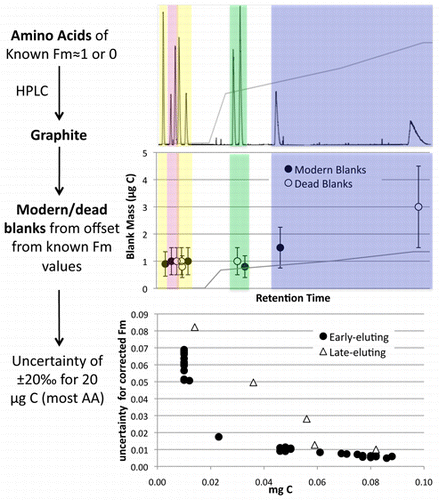当前位置:
X-MOL 学术
›
Anal. Chem.
›
论文详情
Our official English website, www.x-mol.net, welcomes your feedback! (Note: you will need to create a separate account there.)
Radiocarbon Analysis of Individual Amino Acids: Carbon Blank Quantification for a Small-Sample High-Pressure Liquid Chromatography Purification Method
Analytical Chemistry ( IF 6.7 ) Pub Date : 2016-03-09 00:00:00 , DOI: 10.1021/acs.analchem.5b03619 Amy L. Bour 1 , Brett D. Walker 2 , Taylor A. B. Broek 1 , Matthew D. McCarthy 1
Analytical Chemistry ( IF 6.7 ) Pub Date : 2016-03-09 00:00:00 , DOI: 10.1021/acs.analchem.5b03619 Amy L. Bour 1 , Brett D. Walker 2 , Taylor A. B. Broek 1 , Matthew D. McCarthy 1
Affiliation

|
Compound-specific radiocarbon analysis (CSRA) of amino acids (AAs) is of great interest as a proxy for organic nitrogen (N) cycling rates, dating archeological bone collagen, and investigating processes shaping the biogeochemistry of global N reservoirs. However, recoverable quantities of individual compounds from natural samples are often insufficient for radiocarbon (14C) analyses (<50 μg C). Constraining procedural carbon (C) blanks and their isotopic contributions is critical for reporting of accurate CSRA measurements. Here, we report the first detailed quantification of C blanks (including sources, magnitudes, and variability) for a high-pressure liquid chromatography (HPLC) method designed to purify individual AAs from natural samples. We used pairs of AA standards with either modern (M) or dead (D) fraction modern (Fm) values to quantify MC and DC blanks within several chromatographic regions. Blanks were determined for both individual and mixed AA standard injections with peak loadings ranging from 10 to 85 μg C. We found 0.8 ± 0.4 μg of MC and 1.0 ± 0.5 μg of DC were introduced by downstream sample preparation (drying, combustion, and graphitization), which accounted for essentially the entire procedural blank for early eluting AAs. For late-eluting AAs, higher eluent organic content and fraction collected volumes contributed to total blanks of 1.5 ± 0.75 μg of MC and 3.0 ± 1.5 μg of DC. Our final measurement uncertainty for 20 μg of C of most AAs was ±0.02 Fm, although sample size requirements are larger for similar uncertainty in late-eluting AAs. These results demonstrate the first CSRA protocol for many protein AAs with uncertainties comparable to the lowest achieved in prior studies.
中文翻译:

单个氨基酸的放射性碳分析:小样品高压液相色谱纯化方法的碳空白定量
氨基酸(AAs)的化合物特异性放射性碳分析(CSRA)作为有机氮(N)循环速率的代名词,考古骨胶原的年代测定以及影响全球N储层生物地球化学研究过程的研究备受关注。但是,从自然样品中可回收的单个化合物的量通常不足以用于放射性碳(14C)分析(<50μgC)。限制程序性碳(C)空白及其同位素贡献对于报告准确的CSRA测量至关重要。在这里,我们报告了一种用于高压液相色谱(HPLC)方法的C空白样品(包括来源,大小和变异性)的首次详细定量分析,该方法旨在从天然样品中纯化单个AA。我们使用了具有现代(M)或死(D)分数现代(Fm)值的AA标准对,以量化几个色谱区内的MC和DC空白。测定了单独和混合AA标准进样的空白,峰进样量为10至85μgC.我们发现通过下游样品制备(干燥,燃烧和石墨化)引入了0.8±0.4μg的MC和1.0±0.5μg的DC。 ),基本上占了早期洗脱AA的整个程序空白。对于后期洗脱的AA,较高的洗脱液有机物含量和馏分收集体积有助于产生1.5±0.75μgMC和3.0±1.5μgDC的总空白。我们对大多数AA的20μgC的最终测量不确定度为±0.02 Fm,尽管对于晚洗脱AA的类似不确定度,样本量要求也更大。这些结果证明了许多蛋白质AA的第一个CSRA方案,其不确定性可与先前研究中获得的最低相比。尽管对于后期洗脱AA中类似的不确定性,样本量要求更大。这些结果证明了许多蛋白质AA的第一个CSRA方案,其不确定性可与先前研究中获得的最低相比。尽管对于后期洗脱AA中类似的不确定性,样本量要求更大。这些结果证明了许多蛋白质AA的第一个CSRA方案,其不确定性可与先前研究中获得的最低相比。
更新日期:2016-03-09
中文翻译:

单个氨基酸的放射性碳分析:小样品高压液相色谱纯化方法的碳空白定量
氨基酸(AAs)的化合物特异性放射性碳分析(CSRA)作为有机氮(N)循环速率的代名词,考古骨胶原的年代测定以及影响全球N储层生物地球化学研究过程的研究备受关注。但是,从自然样品中可回收的单个化合物的量通常不足以用于放射性碳(14C)分析(<50μgC)。限制程序性碳(C)空白及其同位素贡献对于报告准确的CSRA测量至关重要。在这里,我们报告了一种用于高压液相色谱(HPLC)方法的C空白样品(包括来源,大小和变异性)的首次详细定量分析,该方法旨在从天然样品中纯化单个AA。我们使用了具有现代(M)或死(D)分数现代(Fm)值的AA标准对,以量化几个色谱区内的MC和DC空白。测定了单独和混合AA标准进样的空白,峰进样量为10至85μgC.我们发现通过下游样品制备(干燥,燃烧和石墨化)引入了0.8±0.4μg的MC和1.0±0.5μg的DC。 ),基本上占了早期洗脱AA的整个程序空白。对于后期洗脱的AA,较高的洗脱液有机物含量和馏分收集体积有助于产生1.5±0.75μgMC和3.0±1.5μgDC的总空白。我们对大多数AA的20μgC的最终测量不确定度为±0.02 Fm,尽管对于晚洗脱AA的类似不确定度,样本量要求也更大。这些结果证明了许多蛋白质AA的第一个CSRA方案,其不确定性可与先前研究中获得的最低相比。尽管对于后期洗脱AA中类似的不确定性,样本量要求更大。这些结果证明了许多蛋白质AA的第一个CSRA方案,其不确定性可与先前研究中获得的最低相比。尽管对于后期洗脱AA中类似的不确定性,样本量要求更大。这些结果证明了许多蛋白质AA的第一个CSRA方案,其不确定性可与先前研究中获得的最低相比。







































 京公网安备 11010802027423号
京公网安备 11010802027423号